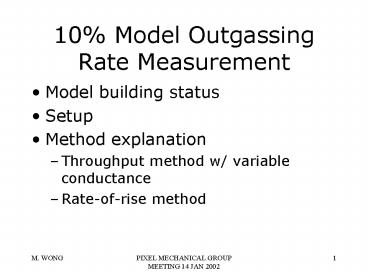10% Model Outgassing Rate Measurement - PowerPoint PPT Presentation
1 / 15
Title:
10% Model Outgassing Rate Measurement
Description:
When the orifice size changes, what happens to: P1 ... Use largest orifice. P1 settles at steady-state condition. Then, change to blank position ... – PowerPoint PPT presentation
Number of Views:83
Avg rating:3.0/5.0
Title: 10% Model Outgassing Rate Measurement
1
10 Model Outgassing Rate Measurement
- Model building status
- Setup
- Method explanation
- Throughput method w/ variable conductance
- Rate-of-rise method
2
Assembly Status Shingled Substrate
3
Assembly Status Dummy Silicon
- Silicon assembly
- ROC
- Sensor
- HDI
- Almost complete
4
Assembly Status
- Substrate to be modified to fit dummy silicon
assemblies
5
Test Setup - Chamber
- Stainless steel
- 19.5 inches ID
- 66 inches length
6
Test Setup Vacuum Vessel
- 3 turbo pumps in parallel
- Total pumping speed 2550 L/sec
- Fixed rotating disk dividing chamber into 2
volumes - Rotating disk with different sized holes
7
Test Setup Vacuum Vessel
- Volume 1 (w/ sample) 50 length
- Volume 2 16 length
- RGA
8
Test Setup Variable Conductance
- Rotate disk to different pumping speeds between
volumes - 2, 23, 6
- Largest A500 cm2
- Blank (no seals between disks)
9
Methods to measure gas load
- Throughput method with variable conductance
- Measurements at pressures between 10-3 10-6
torr - Extrapolate to 10-7 torr (test cant reach this)
- Rate-of-rise method
- Cross-check measurements from throughput method
10
Throughput method w/ variable conductance
- For a given orifice size
- QP1SP2Spump
11
Assumptions
- Q nd na
- where Q outgassing rate
- nd desorption rate
- na adsorption rate
- Outgassing rate is dependent on chamber pressure
- Decrease pressure, decrease na, more accurate
measure of Q
12
Capability of Test Setup
- When the orifice size changes, what happens to
- P1
- ratio of sample surface area (3 m2) to effective
area of pumping orifice (S/11.6 L/sec-cm2)
13
Assumptions in Test Design
- Constant gas load of 0.01 torr-L/sec (Q is
independent of P1) - Outgassing rate of test chamber is negligible
- Flow through orifice is air _at_ room temperature
14
Varying pumping speed
Ratio sample surface area (3m2) effective
area of pumping orifice
15
Rate-of-Rise Method
- Different than previous rate-of-rise test
- Use same test chamber
- Use largest orifice
- P1 settles at steady-state condition
- Then, change to blank position
- Long settling time
- Measure outgassing rate at beginning of transient
- Use as a cross-check for throughput method































